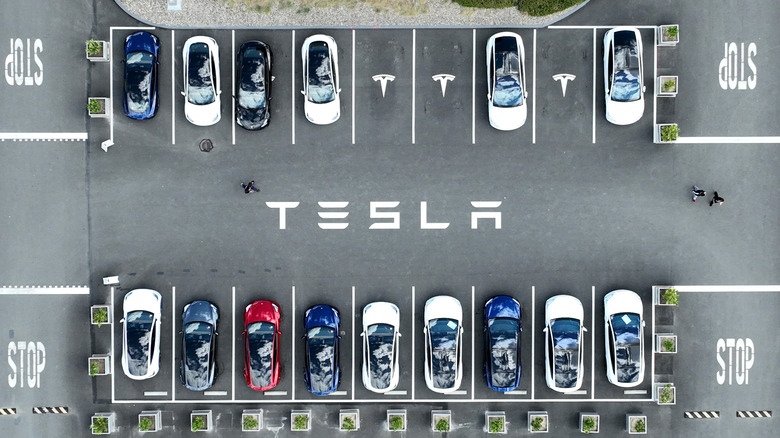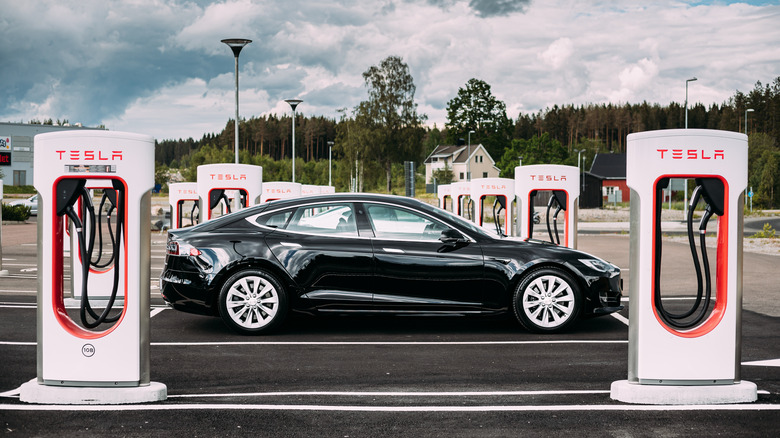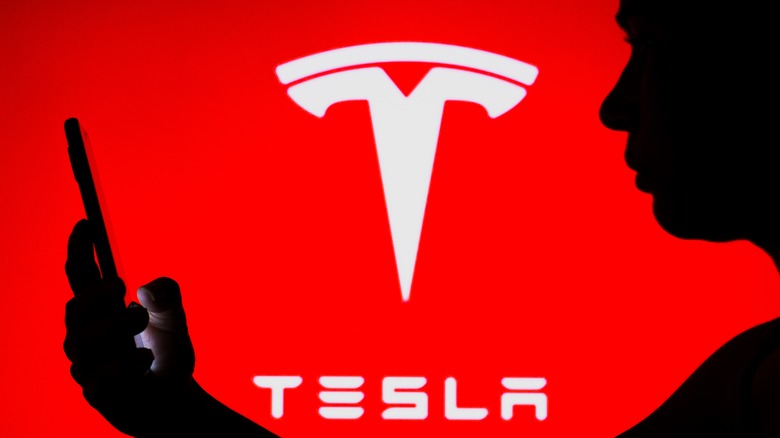How To Set Up A Tesla Charge Schedule, And Why You Might Want To
Charging your Tesla is a key task in owning one of these EVs. In order to drive the vehicle, you'll need to maintain its charge. For many, this means plugging the car in when you arrive home at the end of the day.
But simply plugging and forgetting is a novice mistake when it comes to EV ownership. Tesla makes it easy to micromanage the charging function of your EV, and using these features to your advantage is a necessary step to take. The charge schedule option is one crucial feature that you simply can't afford to ignore. Tesla notes that you can utilize a scheduled charge or scheduled departure setting to make the most of your vehicle's capabilities.
This tool allows you to select the perfect charging window for your schedule. Everyone will need a slightly different routine in this regard, and so setting up the perfect companion charging schedule to your own will make for a more efficient use of the car, and can even promote better battery health and a lower total electricity bill at the same time.
This is a simple task and will only take minutes to complete. However, the difference it makes can be massive when considering maintenance schedules, cash flow management, and effective range performance from your primary mode of transportation.
Take advantage of price windows for a cheaper charge
Setting a charge schedule allows you to take control of precisely when your car will be charging. This is an important feature for homeowners who are concerned about astronomical price rises in their electricity bill. The Bureau of Labor Statistics notes a dramatically rising cost of electricity in the United States through 2022 with a slight tapering off occurring in November (the last month that data is available as of January 2023). This jump in price per kWh means that the cost to charge an EV (and EV ownership more broadly) is noticeably more expensive than it was a year prior.
Electricity prices will vary by local area, but generally speaking, Energy Sage reports that peak price times raise the cost of electricity between 3:00 p.m. and 9:00 p.m. each day. This means that plugging in your EV when you arrive home without setting a schedule will ensure you pay the highest prices possible for the electricity required to recharge the car's battery. Energy Sage notes that between 4:00 and 9:00 you may be looking at a price per kWh that more than doubles your off-peak cost, and a still-enlarged price in the shoulder hours from 3:00 to 4:00 p.m., and lasting from 9:00 until midnight.
Setting a timer to take advantage of off-peak pricing can give you an edge when it comes to managing your electricity bill, while still ensuring that your car is charged up and ready to go.
Maintain a healthy maximum capacity of around 80%
The truth about EV range is that you'll rarely need the full capacity. Some EV users will go days at a time without recharging their vehicle because it just isn't necessary to support their daily commute and other usage requirements. EV Box reports that the average electric vehicle has a range of 211 miles as of December 2022. This can support roughly a full work week of driving without a single recharge based on average commuter statistics (via Zippia) that calculate the typical roundtrip at 41 miles per day.
Using the Tesla charge limit function, in addition to the charging schedule (as suggested by Everyday Chris), a Tesla owner can effectively maintain far more than enough charge in their vehicle. Both of these features work in tandem to support regular driving needs, while ensuring that their battery remains healthy, and their wallet full.
With a charging schedule set, you can rest easy knowing that your charger won't be leeching electricity that isn't strictly necessary while plugged in. Similarly, you won't have to remember to run out to the garage to plug the car in for the next day's commute while trying to save on your energy bills, or promote better EV battery performance.
Set start or end times in the Tesla app
In simple terms, the charging schedule can be set with either a start or end time. With either metric, your car and charger work together to calculate when to begin and end a charging session. Everyday Chris reports that the most efficient setting is the departure time (rather than the initiation setting). With this setting engaged, and working in coordination with any charge limit you may have set, your car will calculate how long it needs to actively charge for in order to reach capacity before you unplug the vehicle to get on the road. If you need three hours of charging, for instance, and set the departure time for 7:00 a.m., the charger will automatically engage at 4:00 a.m. to provide the precise level of battery juice that you've specified.
This is a simple setting to engage in the Tesla app, but it's one that will continue to pay huge dividends long into the future. By utilizing a departure time to manage the engagement and cut off of your charging, you can facilitate a more cost-effective charging strategy that ensures your vehicle remains charged and ready for use and a lower overall electricity bill.



